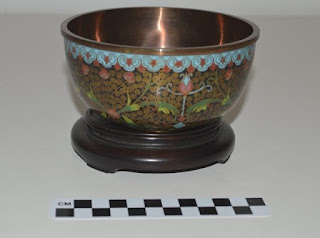This little container or trinket box is on display in the downstairs hall gallery of the Benton County Historical Society's Corvallis Museum.
The intricate pattern is made by taking thin wires of gold, silver, copper or other metal and applying them to the surface of a metal object to form the design. The cells (or “cloisons”) created by the wires are filled with a powdered enamel in the chosen color and the object is fired. Repeated applications of enamel and subsequent firings may be necessary until the surface is even with the top of the wire. The object is then polished. The wires will still be visible, outlining the colored areas of the design.This process, called cloisonne, originated in the Middle East in the third millennium BCE and was initially used to make jewelry. Sometimes colors was created by fitting pieces of colored glass or gems into the cells created by thin pieces of metal. Under the Byzantine Empire, thinner wire was used for the outlines, enamel was used instead of glass, and designs became more pictorial. People fleeing as that empire collapsed, introduced the process to China where it was used to decorate bowls, vases and other larger items. The cloisonne bowl pictured was made in China during the Qing dynasty (1644-1912). Japan also became a center for cloisonne, especially during the 1890-1910 period.
I have always admired the skill and patience of the artisans who apply the powdered enamel to the tiny spaces with a small spatula, brush, or dropper. That part of the process remains unchanged. A change in technique has made creating the basic design with wire a bit easier. Now instead of soldering the wire to the base (usually copper), the object is coated with a clear enamel and then the wire is glued to the surface. Firing melts the glue and fuses the wire to the surface. Then the painstaking process of applying the enamel begins.
There are a number of other beautiful cloisonne items in the same gallery case as the objects shown above. Come and marvel at the workmanship.





No comments:
Post a Comment